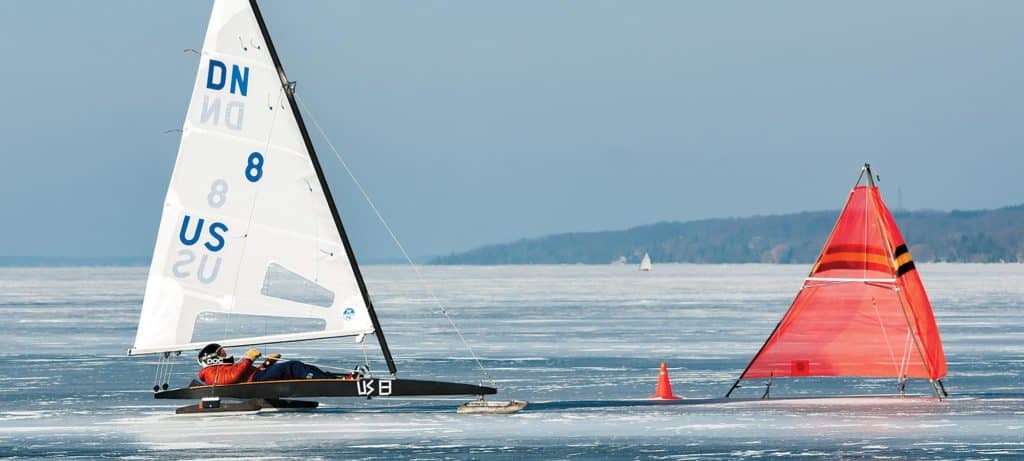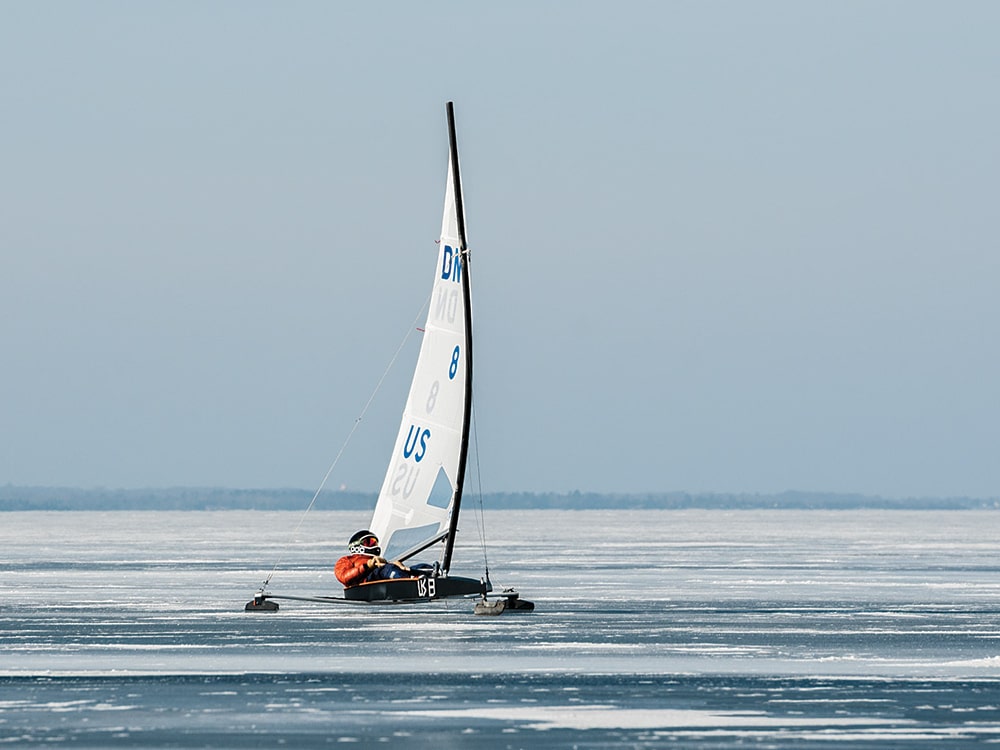
I look to my left and then to my right and think, I can outrun these guys. I’m rocking the boat, carving channels in the ice so my runners don’t stick. One hand is on the tiller, and the other is clenching the limp wire shroud. The stay flexes as I rhythmically push and pull the boat, building up potential energy, like drawing a bow. When the race starts, I want to be on the back stroke so I can catapult it forward and sprint away from the line.
When I go, I’ll be running full tilt, steering as I sprint like a 50-yard-dash maniac. I can cheat the boat into the wind to climb high on the guy to leeward of me before jumping in the boat and bearing off for speed. Other DN sailors tell me it’s better to immediately bear down to get it going and reaching over the guy beneath me, building speed while doing so.
I wouldn’t know either way, because it’s my first DN iceboat start, my first race and really only my fifth time sailing my DN. Bolted to US 8 is a set of used runners I bought hours before the regatta, and frankly, I have no idea what I’m doing out here on the ice. But I’ve always been a fast runner, and the week before, at the gym, I did sprints to condition my legs and make sure I don’t pull a hamstring.
The starting line is a nylon-webbing strap pulled taut to the ice. Half the fleet faces the wind on port tack, the other half on starboard. The leeward runner has to be close to the webbing. Everyone has a starting place based on rank, marked with little metal medallions on the webbing. High rankings and previous finish orders determine your placement. Even numbers start on starboard tack, odd on port, with lower numbers starting in the middle. On account of my registering late, I’m pretty far to the outside, low 30s, with only two boats outside of me.
I’m uncertain how the whole start thing goes, but I’m rocking my boat and ready, channeling my inner Usain Bolt. While I wait for a clue that signals a start, I’m confident, thinking, I have a decent chance for a good finish. With any luck, maybe I can qualify for the gold fleet. How hard can it be?
I have no idea.
All I know is I’m just going to start when the guy next to me moves. I got to the regatta late. I’m tired from my solo drive halfway across the country and through the night. I haven’t had a healthy meal in days. I didn’t even have time to read the sailing instructions, but I know the course is windward/leeward. How many times? I have no idea.
If I have to put my bow down and ease my sheet to get around the mark I’m going to have problems. Losing control and spinning out come to mind.
When the racer to windward of me lunges forward, I push and run, head down, like an Olympic bobsledder. The javelin-throwing cleats I bought on eBay bite into the ice, and I sprint until I find myself having to hold the boat down by the shroud as the boat accelerates and the windward runner starts to sky. I step one foot on and continue to push with the other, as though I’m kicking a scooter down the road.
I clumsily drop into the cockpit, settle in and get low. My heart is racing, and I’m thinking, Don’t sheet in; don’t choke the sail. The boom is trimmed onto my right shoulder, pinning me in the cockpit.
The guy next to me is rolling. Maybe I should pull more sheet on. Maybe I should bear away. I search for an answer while the boat rattles across the ice, runners hitting bumps and imperfections in the ice. The boat resonates like some sort of large, hollow musical instrument. I’m in the moment, in the zone, in the noise, staring at the telltales. I don’t want to stall the sail, but I’m not sure how its shape is really supposed to look. There are no other boats to be concerned about hitting, so I focus on my speed until I’m near the layline. Boats nearby start to tack. I question my tactics. Should I go too? Tacks are costly, I think. I’m trying to go fast, to settle my nerves. I don’t need to outthink anyone. I just need to keep the thing moving. There are no waves, no visible puffs on the water to gauge what the wind is doing. All I have are those seven telltales to rely on as I steer around snow piles, avoiding them like Boston potholes.
I can’t wait anymore. There’s only one boat outside of me. It’s time to tack. I slide forward in the cockpit, push the tiller slowly and ease the mainsheet so I can get my head underneath the boom. It still bangs against my helmet.
The turn seems like an eternity, but the sail comes across and I trim it again. Not the best tack, but I don’t get stuck in irons. Now I’m on the layline and possibly overstood. Without any traffic, I make it safely around the mark, complete the remaining laps and finish 29th of 42. Hey, it’s not last place, but it’s my first taste of DN racing.
Plus, I didn’t hit anyone, and that was it for the day. No gold fleet for me. I’m solid silver, and I’m cool with it.
As twilight arrives, I kick and glide 2 miles back to shore, where a friend from New England suggests I tie my boat to his for the night. I didn’t bring an ice screw because I didn’t know I needed one to keep my boat from being blown to the other side of the lake. Sleep comes easy. I’m exhausted and intent on getting to the ice early.

2018 DN NAs Iceboat Championships Lake Charlevoix
The Charlevoix, Michigan, air is frigid under a hazy cloud cover when I arrive to rig. The place is bustling with racers swapping sails and runners, and race-committee types firing up their four-wheelers. The forecast is for stronger winds, so now I’m apprehensive because my sail is designed for lighter conditions. I’ll be overpowered and slow, but it’s the only sail I have. I also realize I’m overthinking everything.
When I get to the starting area 2 miles downwind, the wind is at least 10 knots in the gusts. It’s hard to tell because winter wind is denser, but I can feel its weight against my face. The ice plate groans like a distant jumbo jet, an eerie sound caused by racers practicing. I’m excited to race, and when my time comes, I find my little medallion on the webbing. To my right is Chris, who I know from Nantucket, Massachusetts. He’s been racing DNs for a few years and still relatively new to it.
I know how the starting system works now, and again, I’m thinking my running ability will give me a head start into clean air. I slide the boat back and forth, start on time, put the bow down and get it flying as soon as possible. As I run, my cleats slap the ice. I try to load the rig, and focus on having a smoother entry into the cockpit. Once I’m in, I take a quick look around. I’m in a good position, paralleling and keeping pace with Chris.
It’s windier today, so I know I can two-block it, flattening the sail. I’m trying to keep all the telltales streaming. Chris squirts out and is suddenly 50 yards ahead, faster and higher. In the moment, I find myself questioning everything again: What am I doing wrong?
It’s windier today, so I know I can two-block it, flattening the sail. I’m trying to keep all the telltales streaming. Chris squirts out and is suddenly 50 yards ahead, faster and higher. In the moment, I find myself questioning everything again: What am I doing wrong?
I regain my composure but realize I’m now high of the mark, doing what feels like 40 knots. A boat in front of me tacks, gets walloped by a gust, spins 180 degrees and wipes out. I think, This is getting crazy. There’s another one approaching on port tack. I’m on starboard, but I don’t know what to do about him. Careening into the mark, I’m nervous. I have other issues, and it’s all snowballing. He’s out of control, I’m out of control, and all I’m thinking is, I hope he tacks.
He does tack, and in a heartbeat, his rig buckles. I’m high of the layline and coming into the mark fast, faster than I’ve ever sailed. In the chaos I see a group of race-committee people and observers sitting just above the mark with their four-wheelers. If I have to put my bow down and ease my sheet to get around the mark I’m going to have problems. Losing control and spinning out come to mind. The gap between them and the mark looks too small. If I turn and suddenly have no way out, I’ll surely plow into the race committee. Back and forth in mind is a rapid volley of attempted logic: How do I turn? Shoot, what do I do? How do I get out of this alive? Do I stay on the course or bail?
Screw it. I stuff the boat into the wind, sail off the course and shoot above the race committee. I calm my nerves before turning back downwind and onto the course the long way.
Before the next race, Steve Madden, another New England fleet guy, who went on to win the silver fleet, explains to me that I need to lean out of the boat and hike it flat to make the turn. When the opportunity arrives in the following race, it’s the same, with the race committee and observers and a seemingly small gap, but now there are other boats around as well. It’s like going into a corner in NASCAR. It may not look pretty or aerodynamic, but I’m hanging halfway out of the cockpit. I have to pinch to make the mark, which means I’m slow, with less apparent wind. Boats zip past me as if I’m on the side of a highway, passing 18-wheelers spraying me with slush. Still, I make it around, learning how to tame this thing one day and one race at a time. I can’t wait to sail and race again, but sadly, spring is here.
I ask myself, “What’s the equivalent of frostbiting for an iceboater?”









